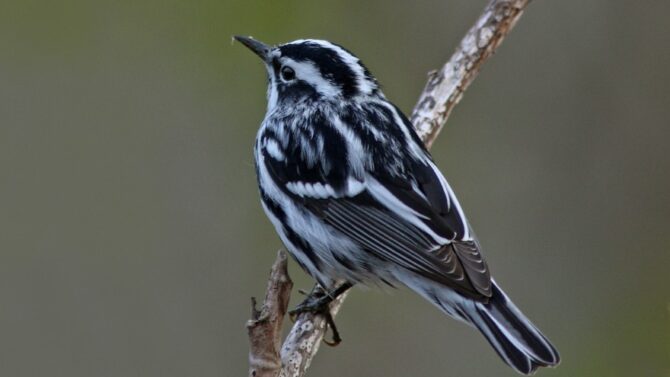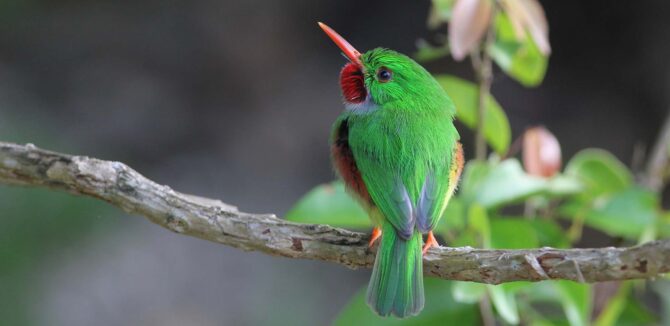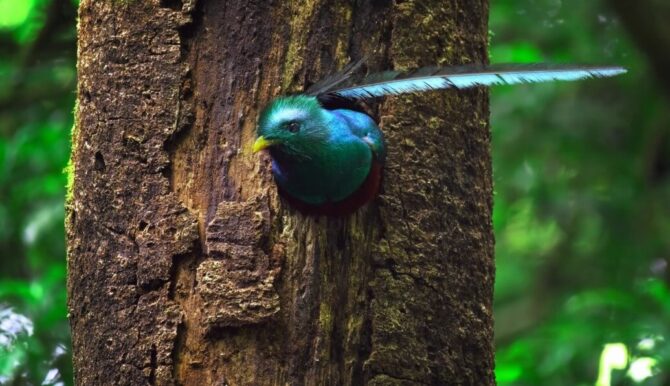Black and white colored birds are popular and often seen outdoors.
Many people prefer this color pattern on birds to brighter ones like yellow, blue, or purple, and their birdwatching consists of spotting these species that may sometimes look different under the light.
If this is you, you’ve come to the right place.
Black and white birds include the yellow-rumped warbler, black-and-white warbler, downy woodpecker, and dark-eyed Junco, to mention a few.
Read on to discover more species, including some facts to know bout them.
Examples of Black and White Birds
1. Black-and-white Warbler
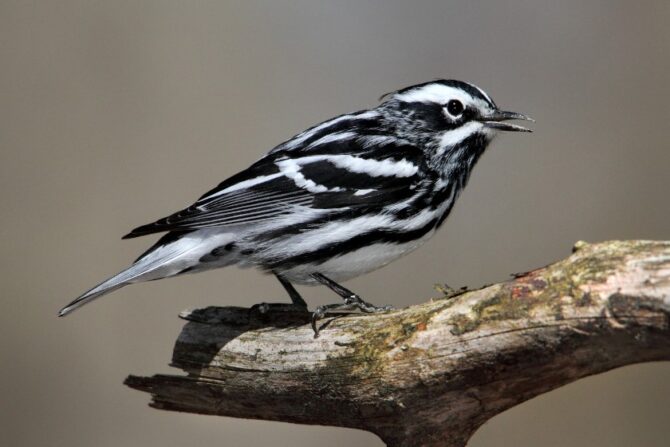
- Scientific Name: Mniotilta varia
- Length: 4.3 to 5.1 inches
- Weight: 0.28 to 0.53 ounces
- Wingspan: 7.1 to 8.7 inches
- Habitat: Deciduous forests
- Where Found: North America
- Conservation Status: Least Concern
The black and white warbler is a member of the Parulidae family and the only species in its genus Mniotilta.
It is one of the best examples of a black-and-white colored bird, which is why it takes first place on our list.
This bird can be found in the deciduous forests of North America, though in the non-breeding season, it can stay in any habitat.
Just as the name states, this warbler is colored and streaked black and white.
Males and females are similar, the only difference being that the male has a black cheek while the female is grey. Younger ones have a lot of spots.
You can easily spot them on tree trunks and branches looking for insects.
2. Yellow-rumped Warbler
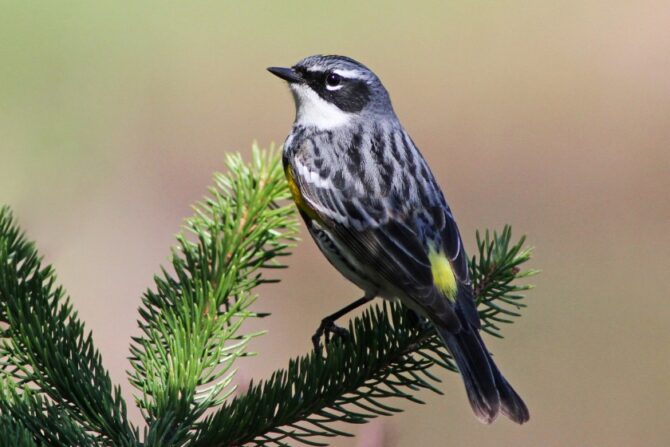
- Scientific Name: Setophaga coronata
- Length: 5.5 inches
- Weight: 0.3 to 0.4 ounces
- Habitat: Evergreen forest and edges
- Where Found: North America
- Conservation Status: Least Concern
The yellow-rumped warbler is another member of the Parulidae family and the genus Setophaga.
It occurs throughout the North American continent, going from the United States to Canada down to Central America.
Its habitats include coniferous forests, mixed coniferous-deciduous forests, and even some open areas.
The yellow-rumped warbler has black and white streaks with other colors like gray and a yellow rump.
The latter color is what brought about its name. There are four forms of the yellow-rumped warbler, all of which have their variants.1
The yellow-rumped warbler can stay close to humans, and you can draw them to your yard using suet, raisins, peanut butter, and sunflower seeds.
3. Black-throated Gray Warbler

- Length: 4.3 to 5.1 inches
- Weight: 0.3 ounce
- Wingspan: 7.5 to 7.8 inches
- Habitat: Deciduous forests, mixed coniferous, deciduous forests
- Where Found: North America
- Conservation Status: Least Concern
The black-throated gray warbler is of the Setophaga genus and—alongside other New World Warblers—is a native of North America.
It dwells in habitats like deciduous and mixed coniferous forests. Very few can be found in Western Europe.
This warbler has three main colors on its plumage: black, gray, and white. The black-and-white colors come in streaks, and the black is colored gray.
There’s also a small yellow spot on the face. Overall, the plumage is soft. They can be found on trees inside their forest habitats.
4. Downy Woodpecker
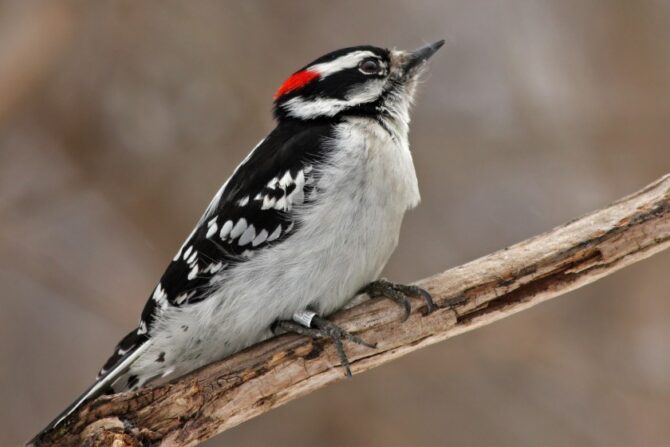
- Scientific Name: Dryobates pubescens
- Length: 5.5 to 7.1 inches
- Weight: 0.71 to 1.16 ounce
- Wingspan: 9.8 to 12.2 inches
- Habitat: Deciduous forests
- Where Found: North America
- Conservation Status: Least Concern
The downy woodpecker is a member of the woodpecker family known as Picidae, and it is the smallest in North America, its native continent.
It lives in countries like the United States and Canada, inhabiting forested areas.
This bird is often compared to the hairy woodpecker, another bird on this list.
The black part of the downy woodpecker is the top, while the underside is colored white. The wings and face are streaked black and white.
Males and females are similar, except that females have no red patch on the head.
5. Blackpoll Warbler
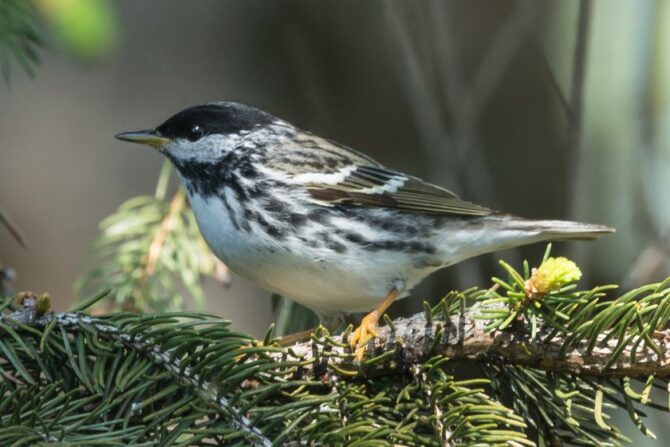
- Scientific Name: Setophaga striata
- Length: 4.9 to 5.9 inches
- Weight: 0.42 to 0.53 ounce
- Wingspan: 7.9 to 8.1 inches
- Habitat: Woodlands, bushy areas
- Where Found: North America
- Conservation Status: Near Threatened
The blackpoll warbler is a native of North America, where it dwells in forests.
You’ll find it in countries like the United States, Canada, and down South America. There are very few in western Europe, where it is considered a rare variant.
The blackpoll warbler is very small and can easily fit in a person’s palms.
The black-and-white coloring is more obvious on the breeding male than it is on females and non-breeding males. Females look more washed out.
6. Hairy Woodpecker
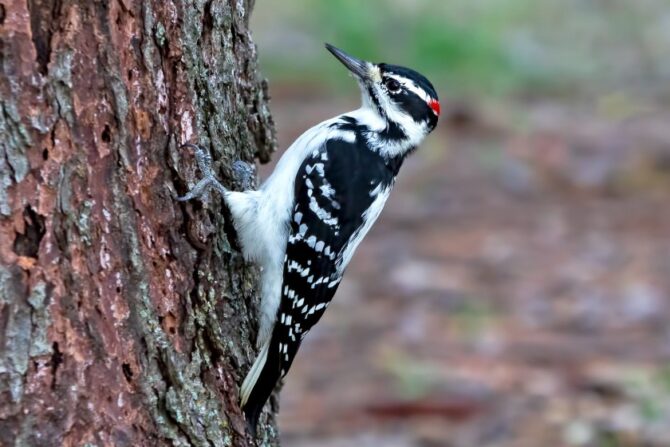
- Scientific Name: Leuconotopicus villosus
- Length: 7.1 to 10.2 inches
- Weight: 1.4 to 3.4 ounces
- Wingspan: 13 to 16.1 inches
- Habitat: Deciduous forest
- Where Found: North America
- Conservation Status: Least Concern
The hairy woodpecker is widespread in North America, and just like other woodpeckers, it lives in wooded areas.
As of 2003, there were over nine million individuals.2 This bird can be found in places like the United States, Canada, Costa Rica, the Bahamas, Mexico, and Nicaragua.
The hairy and downy woodpeckers are very similar; they could pass off as bird twins.
The only difference is that the hairy woodpecker is larger. It is black at the upper part and white underneath, and the male also has a red patch on the head.
7. Dark-eyed Junco

- Scientific Name: Junco hyemalis
- Length: 5.1 to 6.9 inches
- Weight: 0.63 to 1.06 ounces
- Wingspan: 7.1 to 9.8 inches
- Habitat: Coniferous forests
- Where Found: North America
- Conservation Status: Least Concern
The dark-eyed junco is of the genus Junco from which it was named.
It can be found in North America and would often extend to the Northern regions during the summer.
Its preferred habitat includes coniferous forests and other wooded areas.
The main trait of this junco bird is the dark eyes that brought about its name.
The plumage color often varies, but generally, they come with darker upper parts and a white underside. The bill contrasts with the dark shades of the plumage by being pink.
8. Spotted Towhee

- Scientific Name: Pipilo maculatus
- Length: 6.7 to 8.3 inches
- Weight: 1.2 to 1.7 ounces
- Wingspan: 11 inches
- Habitat: Forests, fields, chaparrals
- Where Found: North America
- Conservation Status: Least Concern
The spotted towhee is a member of the Passerellidae family, commonly known as the New World Sparrow.
These birds are also termed seed birds. This bird and the eastern towhee were once considered the same species under the name the rufous-sided towhee.
The spotted towhee is about the size of a robin, and it has a special color pattern.
Males and females differ in significant ways. The head, throat, and back of the male are black, while that of the female is brown.
The sides of its body are red, while the feathers are spotted white. Completing the look is a long, black tail.
9. Eastern Towhee
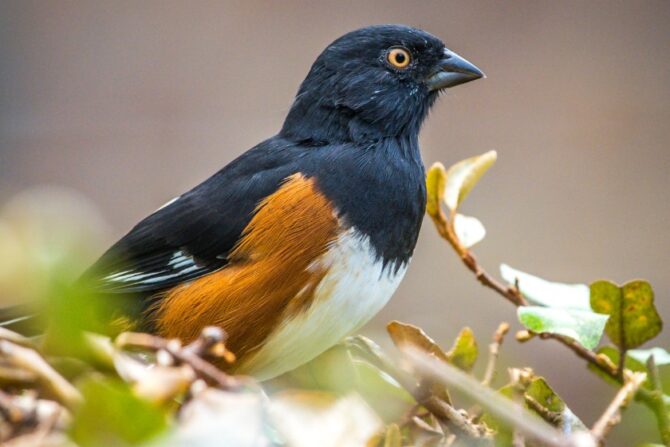
- Scientific Name: Pipilo erythrophthalmus
- Length: 6.8 to 9.1 inches
- Weight: 1.1 to 1.9 ounces
- Wingspan: 7.9 to 11.8 inches
- Habitat: Fields, shrubs
- Where Found: North America
- Conservation Status: Least Concern
The eastern towhee is the already mentioned close relative of the spotted towhee, both of which were considered the same species.
They look alike, except for some spots that are absent from the eastern towhee. They also differ in where they occur in the United States.
The eastern towhee is on the eastern side, while its spotted counterpart is on the west.
The eastern towhee is a large sparrow bird, and the color patterns are similar to that of the spotted towhee.
Males have a black head, upper body, and tail, while the female is colored brown in these areas.
The underside is white, the tail is dark, and the sides are colored rufous.
10. Gila Woodpecker

- Scientific Name: Melanerpes uropygialis
- Length: 8 to 10 inches
- Weight: 1.8 to 2.8 ounces
- Wingspan: 15.8 to 16.5 inches
- Habitat: Deserts, Dry forests
- Where Found: North America
- Conservation Status: Least Concern
The Gila woodpecker dwells in the desert regions of North America, particularly in the United States and Mexico.
You can also find it in small towns. In desert regions, it lives in cacti holes and drills into them when looking for food.
The black-and-white patterns on the wings and back of the bird are similar to that of a zebra.
Other parts of the body (the head, belly, throat, and neck) are a greyish tan.
Males and females are slightly different as the male has a red cap on the head that the female doesn’t have.
11. Black Phoebe
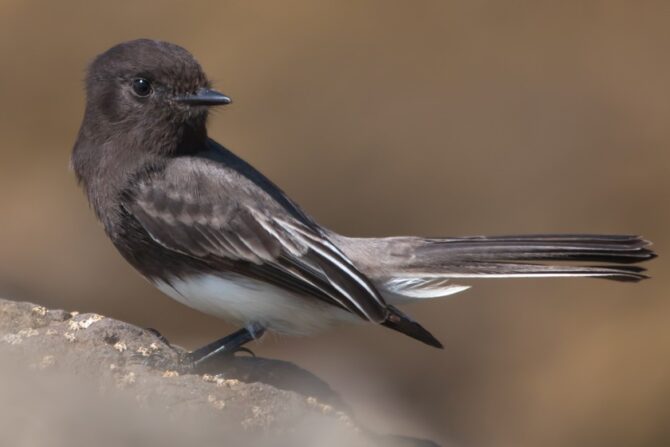
- Scientific Name: Sayornis nigricans
- Length: 6.3 inches
- Weight: 0.5 to 0.8 ounces
- Wingspan: 10 to 11 inches
- Habitat: Walled canyons, towns, farmlands
- Where Found: The Americas
- Conservation Status: Least Concern
The black phoebe is a member of the Tyrannidae family, also known as the tyrant flycatchers, the largest bird family in the world.3
This bird is widespread, going through the North American continent down to the Southern parts.
It is not as migratory as other birds; thus, you can see it year-round in its range. There are six subspecies.
The black phoebe has a predominantly black color, hence the name. Its belly is colored white, giving the black-and-white pattern.
Males and females are similar; only the juvenile has a different plumage which is brown.
12. Warbling Vireo

- Scientific Name: Vireo gilvus
- Length: 4.7 to 5.1 inches
- Weight: 0.3 to 0.6 ounces
- Wingspan: 8.7 inches
- Habitat: Deciduous and mixed woods
- Where Found: North and Central America
- Conservation Status: Least Concern
The warbling vireo is a member of the Vireonidae family, a small songbird that’s a native of North America.
It migrates to the Central part of America, so you can also find it in those areas.
It dwells in habitats like deciduous and mixed woods, picking out insects from the trees.
This bird has a gray and olive upper part, and the underneath is a whiteish yellow. Together it gives the black-and-white pattern, which adds it to this list.
13. Northern Mockingbird

- Scientific Name: Mimus polyglottos
- Length: 8.1 to 11 inches
- Weight: 1.4 to 2.0 ounces
- Wingspan: 12 to 15 inches
- Habitat: Forest edges, open areas
- Where Found: North America
- Conservation Status: Least Concern
The Northern mockingbird is a member of the Mimidae family, commonly known as mockingbirds, due to the ability of some to mimic sounds.4
The Northern mockingbird has this ability. It occurs in North America, specifically in countries like the United States, Canada, the Bahamas, and Mexico.
The upper parts of this species are colored a dark gray, while the underside is white. The bill is black, matching the upper side.
14. Black-billed Magpie
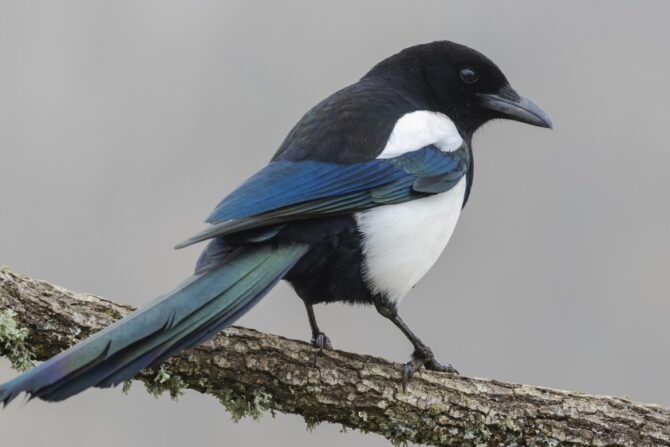
- Scientific Name: Pica Hudsonia
- Length: 18 to 24 inches
- Weight: 5 to 7.6 ounces
- Wingspan: 8.1 to 8.6 inches
- Habitat: Farmlands, suburban areas
- Where Found: North America
- Conservation Status: Least Concern
The black-billed Magpie is a member of the Corvidae (corvid) family, and it goes by the alternative name, the American magpie.
It is a native of North America, and it stretches from the United States to Mexico.
The black-billed Magpie is non-migratory, sticking closely to its range.
This bird has a black and white pattern, with the colors being complementary. Its name comes from the bill, which is dark alongside the face.
This bird has a very long tail. Males and females differ significantly in size and weight, with the male being larger.
15. Northern Flicker

- Scientific Name: Colaptes auratus
- Length: 11 to 14 inches
- Weight: 3 to 6 ounces
- Wingspan: 16.5 to 21.5 inches
- Habitat: Woodlands, yards
- Where Found: North America
- Conservation Status: Least Concern
Though it doesn’t bear the name, the Northern flicker is a woodpecker. It is found in North America, but because of its migratory quality, its range can extend beyond the North.
You can find it in the central regions. This bird goes by many other names, like the yellowhammer.
The Northern flicker has a brown shade, but its upper parts are filled with black spots.
The underside comes in a lighter color. Males and females are similar, except for a stripe on the male that’s absent on the female.
16. Blue-gray Gnatcatcher

- Scientific Name: Polioptila caerulea
- Length: 3.9 to 5.1 inches
- Weight: 0.18 to 0.25 ounces
- Wingspan: 6.3 inches
- Habitat: Open deciduous woods
- Where Found: North America
- Conservation Status: Least Concern
The blue-gray gnatcatcher is a member of the Polioptilidae family, commonly known as gnatcatchers. These birds often occur in North and South America.
The blue-gray is a native of the North, dwelling in open deciduous woods. It is a sweet-sounding songbird.
This gnatcatcher has a darker blue-gray color on the upper parts, while the underside is white.
Females are slightly different from males in that blue is less pronounced. Juveniles come in a greenish-gray color.
17. Bushtit

- Scientific Name: Psaltriparus minimus
- Length: 4.3 inches
- Weight: 0.81 to 0.21 ounces
- Wingspan: 6 to 7 inches
- Habitat: Open woods
- Where Found: North America
- Conservation Status: Least Concern
The bushtit is fully known as the American bushtit, which already shows that this bird is a native of North America.
It belongs to the family Aegithalidae, the bushtit family. This bird dwells mainly in open woods, but you can also find it in parks and gardens.
The American bushtit is a very small bird, one of the smallest in North America. It has a gray-brown plumage overall, but the underside is white.
Males and females are different as the male has dark eyes while the females come with yellow eyes.
18. Barn Swallow
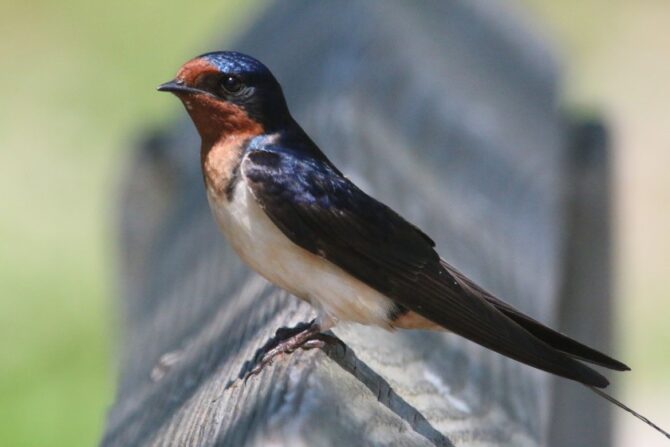
- Scientific Name: Hirundo rustica
- Length: 6.5 to 7.5 inches
- Weight: 0.56 to 0.78 pounds
- Wingspan: 12.5 to 13.5 inches
- Habitat: Pasture, meadows, farmlands
- Where Found: Europe, Asia, Africa, and the Americas
- Conservation Status: Least Concern
The barn swallow is a member of the swallow family known as Hirundinidae. It is the most widespread swallow species in the world.
Unlike other birds on this list, the barn swallow isn’t limited to the Americas. It extends to Europe, Asia, and Africa. Preferred habitats include farmlands, meadows, and pastures.
The barn swallow is dark blue on the upper parts and white on the underside.
It also has an outer tail that’s longer on the male than the female. The sexes are similar, but the female pales in comparison to the male.
19. Eastern Wood-pewee
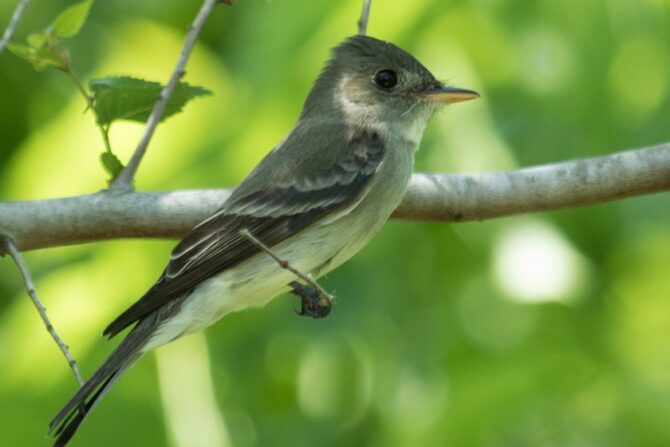
- Scientific Name: Contopus virens
- Length: 5.3 to 5.9 inches
- Weight: 0.49 ounce
- Wingspan: 9.1 to 10.2 inches
- Habitat: Deciduous mixed woods
- Where Found: North America
- Conservation Status: Least Concern
The eastern wood pewee is a member of the Tyrannidae family.
It was once considered the same as another related species known as the western wood pewee, but it has since become independent.
It is a native of North America, particularly on the eastern side, where it inhabits deciduous, mixed woods.
The bird is gray olive in the upper parts with a light underside. The wings look slim because of the wingtips, and it comes with pale wing bars.
Both males and females are similar in size and color.
20. Black-crowned Heron

- Scientific Name: Nycticorax nycticorax
- Length: 22.8 to 26.0 inches
- Weight: 25.6 to 35.8 ounces
- Wingspan: 45.3 to 46.5 inches
- Habitat: Wetlands
- Where Found: The Americas, Europe, Asia
- Conservation Status: Least Concern
The black-crowned heron is a member of the family Ardeidae, the family of herons, egrets, and bitterns (some heron species are also called egrets and bitterns).
This heron also goes by the name black-capped night heron or simply night heron. Its range is wide, covering Europe, Asia, and the Americas. It lives in wetlands.
The black-crowned heron’s back, bill, and crown are all black. The wings are grey; then there’s the white underside.
Another white part of this heron is the long plumes at the top of its head. Males and females are similar, the only difference being that males are bigger.
21. Willow Flycatcher
- Scientific Name: Empidonax Trailli
- Length: 5.2 to 6 inches
- Weight: 0.48 ounce
- Wingspan: 8.5 inches
- Habitat: Deciduous thickets
- Where Found: North America
- Conservation Status: Least Concern
The willow flycatcher is a member of the tyrant flycatcher family, and the name alludes to its insectivorous diet.
It is a native of North America, where all four of its subspecies live. It inhabits deciduous forests.
As a migratory bird, you can sometimes find the willow flycatcher in Central America. Some even go as far as South America.
The willow flycatcher is colored a dark olive brown at the upper parts and a light underside.
The wings and tail are as dark as the upper side, but the wingtips are white. There are very few differences between males and females.
22. Red-headed Woodpecker
- Scientific Name: Melanerpes erythrocephalus
- Length: 7.5 to 9.8 inches
- Weight: 2.0 to 3.4 ounces
- Wingspan: 5 to 5.9 inches
- Habitat: Open country
- Where Found: North America
- Conservation Status: Least Concern
The red-headed woodpecker is a member of the Picidae family and is a native of North America.
You’d find it in countries like Canada and the United States. It dwells in open countries across its range.
It once was classified as Endangered by the IUCN but has since gotten changed to Least Concern.
As the name shows, the red-headed woodpecker comes with a redhead.
The neck is colored red too. The back and tail are both black, while the belly and rump come in white. Males and females are similar.
23. Red-bellied Woodpecker
- Scientific Name: Melanerpes carolinus
- Length: 9 to 10.5 inches
- Weight: 2 to 3.2 ounces
- Wingspan: 15 to 18 inches
- Habitat: Woodlands and forests
- Where Found: North America
- Conservation Status: Least Concern
The red-bellied woodpecker is a native of North America, specifically in the United States and Canada.
It shares similarities with another bird known as the red-headed woodpecker, both of which fall under the Melanerpes genus and can sometimes be confused for each other.
The red-bellied woodpecker stays in woodlands and forests.
This bird has a distinctive combination. The upper parts have a black-and-white barred pattern, while the underside is an unadulterated white.
There’s a red patch on the downside of the belly, which earned it the name. This red patch also appears on the back of the head.
24. Red-naped Sapsucker
- Scientific Name: Sphyrapicus nuchalis
- Length: 7.5 to 8.3 inches
- Weight: 1.1 to 2.3 ounces
- Wingspan: 16.1 to 16.9 inches
- Habitat: Mixed forests
- Where Found: North America
- Conservation Status: Least Concern
The red-naped sapsucker is a member of the Picidae family and was once considered the subspecies of the yellow-bellied sapsucker.
That has since changed, as it is now a separate species. It is a native of North America, where it inhabits mixed forests.
The black-and-white colors are mixed on the plumage, with the white being the stripes on the overall black upper parts.
The underside is white, and the nape is red, as the name shows. The forehead and throat also have this red color.
25. White-headed Woodpecker
- Scientific Name: Leuconotopicus albolarvatus
- Length: 7.9 inches
- Weight: 2.5 ounces
- Wingspan: 7.9 inches
- Habitat: Dry conifer forests
- Where Found: North America
- Conservation Status: Least Concern
The white-headed woodpecker is a native of North America, dwelling in pine forests.
It is nonmigratory, which means you can always find it in its particular range and habitat. Like other woodpeckers, this species drills into trees in search of food.
Not surprisingly, the white-headed woodpecker has a white head. Its plumage is predominantly black, and the males have a red spot at the back of the head.
26. Eastern Kingbird
- Scientific Name: Tyrannus tyrannus
- Length: 7.5 to 9.1 inches
- Weight: 1.2 to 1.9 ounces
- Wingspan: 13 to 15 inches
- Habitat: Open areas
- Where Found: North America
- Conservation Status: Least Concern
The Eastern kingbird is a member of the Tyrannidae family known as tyrant flycatchers.
It is a native of North America, but because it is migratory, you can find it in the south and central regions as well.
It dwells in open area habitats, though it can also appear in fields and shrubs.
This bird has a grey-black upper part with a lighter underside, and added to that is the long black tail with a white end. All these give the white and black combination.
27. Loggerhead Shrike
- Scientific Name: Lanius ludovicianus
- Length: 7.9 to 9.1 inches
- Weight: 1.2 to 1.8 ounces
- Wingspan: 11 to 12.6 inches
- Habitat: Open pastures, grasslands
- Where Found: North America
- Conservation Status: Near Threatened
The loggerhead shrike is a member of the Laniidae family called shrike birds. These birds are also sometimes called butcher birds because of their feeding habits.
The loggerhead shrike is endemic to North America, and it is the only shrike bird with a range limited to the North American continent.
The adult loggerhead shrike is colored grey at the upper parts and white underneath.
Its feet are colored black, and there is also a black mask running across its face. Males and females look very similar, so much so that it is hard to tell them apart.
28. Carolina Chickadee
- Scientific Name: Poecile carolinensis
- Length: 4.5 to 5.1 inches
- Weight: 0.32 to 0.42 ounces
- Wingspan: 6 to 8 inches
- Habitat: Deciduous forest
- Where Found: North America
- Conservation Status: Least Concern
The Carolina chickadee is a member of the Paridae family, a small bird that belongs to the tit family.
It is a native of North America, and you can find it in the United States, staying in cities like Texas, Florida, and Kansas. Preferred habitats include deciduous forests.
They are non-migratory, remaining in one region even during climate changes.
The chickadee’s back is grey at the upper parts, but the underside and parts of the face are white. The bill is dark as well.
Other physical features include the tail, which is only of average level, and a pair of short wings.
29. Tufted Titmouse
- Scientific Name: Baelophus bicolor
- Length: 5.5 to 6.3 inches
- Weight: 0.6 to 0.9 ounces
- Wingspan: 7.9 to 10.2 inches
- Habitat: Deciduous, mixed woods
- Where Found: North America
- Conservation Status: Least Concern
The tufted titmouse is a member of the Paridae family, and it is a native of North America.
It is connected to the black-crested titmouse that was once considered a subspecies.
However, that has since changed as they are both separate species. The tufted titmouse inhabits mixed woods.
The tufted titmouse comes with grey upper parts, a white underside, and a white front.
Topping this is a tuft on top of its head, hence the name. It also has a black forehead which is somewhat reduced in juveniles.
30. Pileated Woodpecker
- Scientific Name: Dryocopus pileatus
- Length: 16 to 19 inches
- Weight: 9 to 11 ounces
- Wingspan: 26 to 30 inches
- Habitat: Deciduous forests
- Where Found: North America
- Conservation Status: Least Concern
The pileated woodpecker is a member of the Picidae family, a native of North America, and inhabits deciduous forests, wooded parks, and mature forests.
You can find it in the eastern parts of the continent, staying in Canada and the United States.
This woodpecker bird is generally black, with white lines on the face going down to the white throat.
The undersides of the wings are white as well. The next obvious physical feature is the red crest at the top of its head.
Final Thoughts
There are different birds in the world, and on this list, we’ve explored the black and white birds, most of which are found in the Americas.
Not all these birds are purely black, but they all are similar in that they have dark and white sides. Usually, it is the underside that’s colored white.
References & Notes
- Yellow-rumped Warbler. iNaturalist.
- Leuconotopicus villosus (Hairy Woodpecker). Avibase.
- Largest family of birds. Guinness World Records.
- Listen to the Mockingbird. The National Wildlife Federation.
